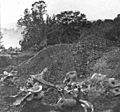Camarasaurus facts for kids
Quick facts for kids CamarasaurusTemporal range: Upper Jurassic
155–145 mya |
|
|---|---|
 |
|
| Camarasaurus lentus skull. | |
| Scientific classification | |
| Kingdom: | |
| Phylum: | |
| Class: | |
| Superorder: | |
| Order: | |
| Suborder: | |
| Infraorder: | |
| Family: |
Camarasauridae
|
| Genus: |
Camarasaurus
Cope, 1877
|
Camarasaurus was a huge plant-eating sauropod dinosaur. Its name means "chambered lizard" because of its unique skull shape. This giant lived during the late Jurassic Period, about 155 to 145 million years ago. It could be as long as 18 meters (about 60 feet) and weigh around 18 metric tons, which is like four elephants! Scientists think these dinosaurs might have lived in groups.
The first Camarasaurus fossil was found in 1877 in Colorado by Oramel W. Lucas. Its fossil remains have been discovered in the Morrison Formation across several U.S. states. These include Colorado, New Mexico, Utah, and Wyoming.
There are four known types, or species, of Camarasaurus:
- C. grandis ("grand chambered lizard")
- C. lentus
- C. lewisi
- C. supremus ("biggest chambered lizard")
You might have seen Camarasaurus in the movie When Dinosaurs Roamed America.
Camarasaurus Skull
Camarasaurus is one of the most commonly found and well-preserved sauropod dinosaurs. The most common type, C. lentus, usually grew to about 15 meters (50 feet) long. The largest type, C. supremus, could reach an amazing 23 meters (75 feet) in length. It might have weighed up to 47 tonnes (about 52 tons).
The skull of Camarasaurus was strong and shaped like an arch. It was quite square with a blunt snout. The skull had many openings, called fenestrae, which made it lighter. Its strong build means paleontologists often find it in good condition.
The teeth of Camarasaurus were about 19 centimeters (7.5 inches) long. They were shaped like chisels and lined up evenly in its jaw. These strong teeth suggest that Camarasaurus ate tougher plants. This is different from other sauropods like diplodocids, which had more slender teeth.
Living in Herds
Scientists found fossils of two adult Camarasaurus and one young one together. This group, including a 12.2-meter (40-foot) long juvenile, died at the same time. This happened about 150 million years ago in northeast Wyoming. It's thought their bodies were washed into river mud where they were preserved.
Finding them together suggests that Camarasaurus might have traveled in herds. They could have even lived in family groups. Also, Camarasaurus eggs have been found in lines, not in neat nests. This hints that, like most sauropods, Camarasaurus probably did not care for its young after they hatched.
Images for kids
-
Skull of Camarasaurus sp. AMNH 467 at the American Museum of Natural History.
-
Skull in mudstone matrix, Dinosaur National Monument
See also
 In Spanish: Camarasaurus para niños
In Spanish: Camarasaurus para niños







